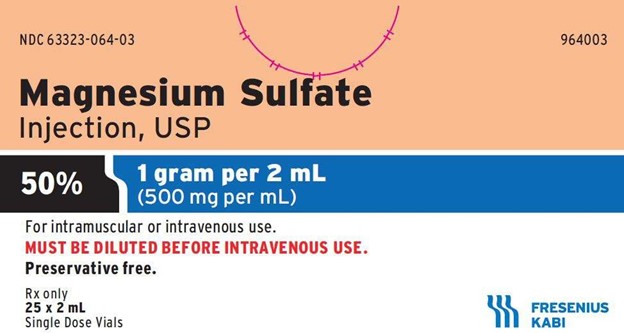A patient is to receive magnesium sulfate 2 grams per hour at 50 mL/hour rate of infusion.
How much magnesium sulfate must be added to 1000 mL normal saline to provide the ordered infusion?
10g
20 g
30 g
40 g
The Correct Answer is D
To calculate the amount of magnesium sulfate to be added to the normal saline, we can use the formula:
Concentration = Dose / Volume Plugging in the given values, we get:
Concentration = 2 g / 50 mL Simplifying, we get:
Concentration = 0.04 g/mL
To find the amount of magnesium sulfate needed for 1000 mL of normal saline, we can multiply the concentration by the volume:
Amount = Concentration × Volume Amount = 0.04 g/mL × 1000 mL Amount = 40 g
Therefore, 40 g of magnesium sulfate must be added to 1000 mL of normal saline to provide the ordered infusion.

Nursing Test Bank
Naxlex Comprehensive Predictor Exams
Related Questions
Correct Answer is A
Explanation
Dextrose 50%, add 1 mL to 4 mL injectable saline. To obtain 5 mL of 10% dextrose, 0.5 mL of the 50% dextrose should be diluted with 4.5 mL of sterile water or normal saline. Therefore, the nurse should add 1 mL of the 50% dextrose to 4 mL of injectable saline to get a final concentration of 10% dextrose in 5 mL. This will give the client the appropriate dose.
Choice B is incorrect because adding 2 mL of the 50% dextrose to 3 mL of saline would give a final concentration of 20%, which is higher than the prescribed concentration of 10%.
Choice C is incorrect because adding 3 mL of the 50% dextrose to 2 mL of saline would give a final concentration of 30%, which is significantly higher than the prescribed concentration of 10%.
Choice D is incorrect because adding 4 mL of the 50% dextrose to 1 mL of saline would give a final concentration of 40%, which is much higher than the prescribed concentration of 10%.

Correct Answer is A
Explanation
The patient is ordered to receive 0.3 mg/kg of Nubain IV over 10 minutes. The patient weighs 148 lb, which is equivalent to 67.3 kg. To calculate the total amount of Nubain the patient should receive, multiply the weight by the dosage:
67.3 kg x 0.3 mg/kg = 20.19 mg
The Nubain is available in 10 mg/mL, which means there is 10 mg of Nubain in 1 mL of solution. To calculate how many milliliters of Nubain the patient should receive, divide the total amount of Nubain by the concentration:
20.19 mg / 10 mg per mL = 2.019 mL
To calculate how many milliliters per minute the nurse should administer, divide the total volume of Nubain by the infusion time:
2.019 mL / 10 minutes = 0.2019 mL per minute
Rounding to one decimal place, the nurse should administer 0.2 mL of Nubain per minute to the patient.
Whether you are a student looking to ace your exams or a practicing nurse seeking to enhance your expertise , our nursing education contents will empower you with the confidence and competence to make a difference in the lives of patients and become a respected leader in the healthcare field.
Visit Naxlex, invest in your future and unlock endless possibilities with our unparalleled nursing education contents today
Report Wrong Answer on the Current Question
Do you disagree with the answer? If yes, what is your expected answer? Explain.
Kindly be descriptive with the issue you are facing.
